


|
I discovered this remarkable binding on eBay. The photos posted by the seller were not in focus and, as such, one could not identify the tooling with certainty. However one or two imprints led me to suspect that the binder may have been Antoine Ruette. Now that I have this book at home and scanned at 600 dpi, a close comparative study reveals that this binding is indeed the work of Antoine Ruette, as I will demonstrate below. Before this, I should first present some background details concerning this binder. Here is a brief extract from An Essay in the History of Gold-Tooled Bindings by Herbert P. Horne, London 1894, page 147: "Antoine Ruette, the son of Mace Ruette, by his wife Marie Saminiati, was born 5th February, 1609, and received the freedom of the Guild of St. Jean in the quality of a stationer, on the 9th July, 1637. Upon the death of his father, he succeeded to the Office of Binder in Ordinary to Louis XIV., as appears from the title of a book, which he published in 1644: L'Office de la Semaine Saincte. A Pans, Chez Anthoine Ruette, relieur ord. du Roy, rue sainct Jean de Latran deuant fa fontaine S. Benoist. He was confirmed in the office, by a royal breve dated 3rd July, 1650, receiving at the same time, the grant of a lodging for life in the College Royal: and as Binder in Ordinary to the King, he was paid a wage of a hundred 'livres' a year. He published, also, some other books, either without date, or with that of the year 1661." |
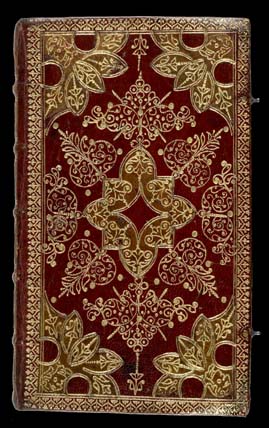
|
Son of one of the greatest binders of the seventeenth century, Antoine Ruette also produced a number of excellent bindings.... high resolution examples of his work are however hard to find, and only a few of those attributed to him may actually turn out to be of his own hand. The above example is from the BLDB (British Library Database of Bookbindings): Les pseaumes de David Paris 1655. The BLDB notes for this binding state: "Binding possibly made by A. Ruette" (See Sale catalogue of Mrs. G. Whitney Hoff, I, Davis 465 p. 100, n. 183, pl. LVII on Les pseaumes de David, Paris, Pierre des Hayes et Anthoine Cellier, 1655). It would be difficult to over-estimate the importance and significance of the extensive gold tooling found on the binding of this small book. An invaluable research aid to those making a comparative study of French 17c decorative bindings. Raphaël Esmerian, a renouned expert in this field, has, from his extensive research, produced an amazing catalogue of the decorative tooling from this period: Douze Tableaux Synoptiques sur La Reliure au XVII eme Siècle, published in 1972. Evidently Esmerian did not know of this British Library example. His table VI - ANTOINE RUETTE 1640-1669 does not include all the tools used on this binding; however, some of the tools are listed.... |

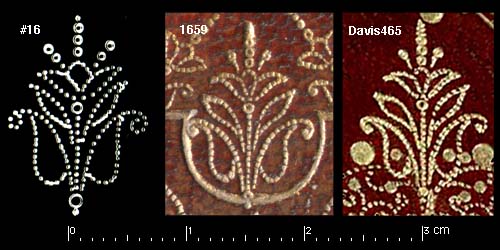
| In the diagram above I have compared Esmerian's tool #16 imprint (my numbering) to more or less identical imprints found on my binding and the Davis example. A closer scrutiny of the two imprints shows them to be identical while Esmerian's illustrated type model appears only 'similar'. I am tempted to think however, that the Esmerian figure is not from an actual rubbing but is rather an 'artistic aproximation'. Note that I have not "cleaned up" the imprints or removed intruding nearby imprint details, which could otherwise be attempted to show each individual imprint on its own. Thus, when I say they are identical, I mean that they would appear so if free of the surrounding elements. |
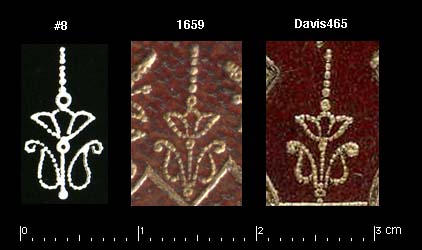
| In this diagram we see that the imprints are again identical, and that Esmerian's type model #8 closely emulates the actual imprint. |

| This imprint is easy to miss in the complex overlapping details of the Davis465 tooling, while the Esmerian model seems rather a mixture of two similar imprints. As such, it will probably be best to separate the two, perhaps as "15" and "15-2" |
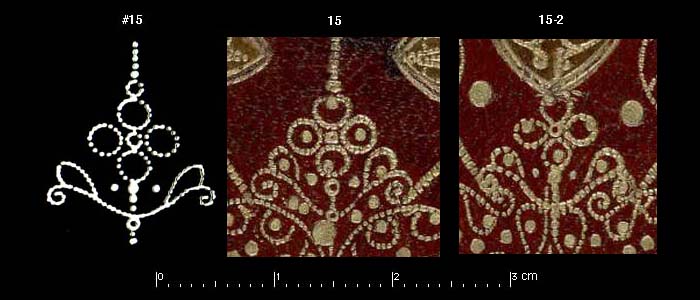
| At this point in my research I was a bit stuck without enough examples to tie everything together. I could find only three near certain examples in the BLDB, however, as two of these were Davis465 and Davis466, I went back and searched number by number through the Davis collection, which appears to be ordered in relation to bindings exhibiting similar characteristics (which can sometimes mean bindings made by the same binder). This was a lucky break as I discovered an important key binding, Davis463... this binding links all the others and allows one to affirm that all these bindings share common tools, which are associated with Antoin Ruette. Let us now examine closely this binding which remains unidentified in the BLDB. |
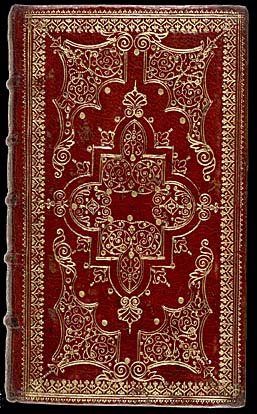
| This book is shown at its actual size. Click on the image to see a 300 dpi enlargement. One of the most prominent common features of these bindings is the outer roll. This roll, which Esmerian has catalogued as a tool from the collection of Mace Ruette, may be a tool that Antoin borrowed from his father's collection. In all three examples, the imprint is blurred and only in a few sections do we see the detail clearly. In these clean sections we find that there are three circular dots within the lower fleuron. |

| I wanted to be sure that the tools of my 1659 binding matched this key Davis463 binding, and so tackled the tricky job of matching the roll details. |

| After some considerable juggling of 600 dpi scans, I finally got the rolls to match up, first matching two long sections of the Davis example, then comparing these with long sections from the 1659 binding. Fortunately I finally discovered some small details which I could trace (such as the three leaning dots shown with the arrows at 'c'), once things are lined up it looks easy; however, I am sure there will be sceptics who will still doubt that these alignments do actually match up. You will notice, however, that the "arms" of the fleurons designated by the arrows from 'a' seem rather stunted and small comparatively, while those from 'b' have a strong "padded shoulder." |
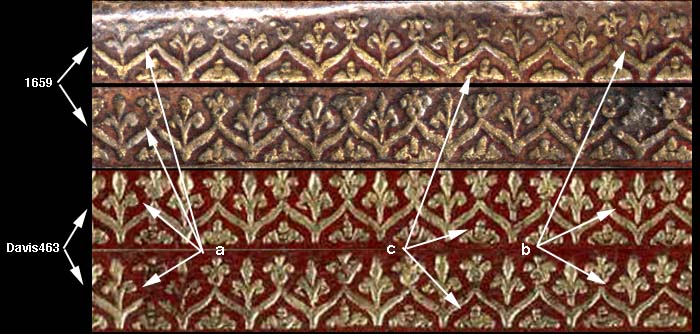
| Before we compare the tools from these three bindings, I would like to present one more, another BLDB binding. As this page seems rather long I will place it at the beginning of the next.... click here to go to the next page. |
| Go to Digital Alchemy | return to the home page of cyclopaedia.org |